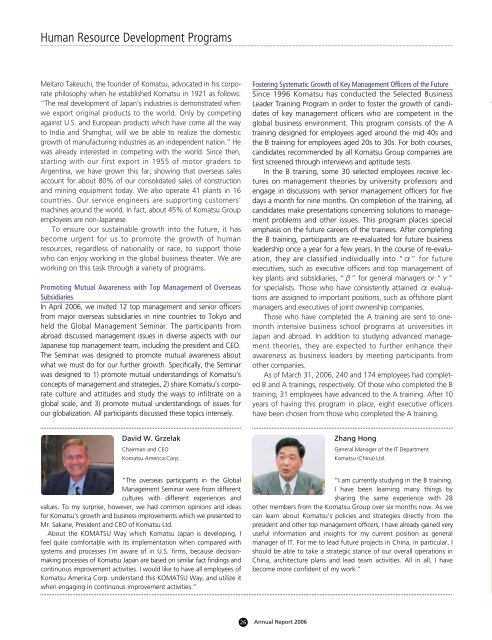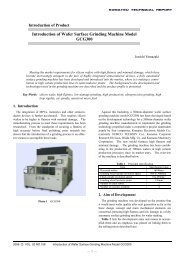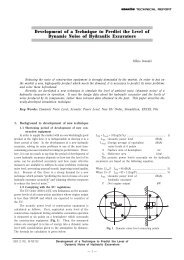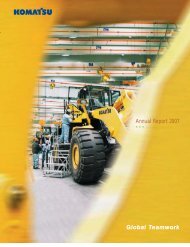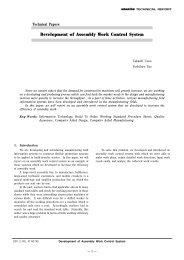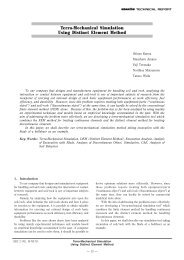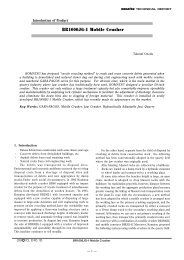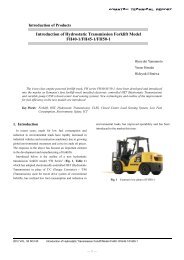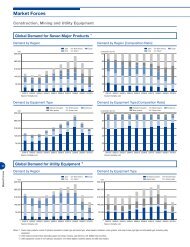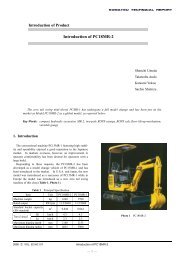Annual Report 2006 - Komatsu
Annual Report 2006 - Komatsu
Annual Report 2006 - Komatsu
You also want an ePaper? Increase the reach of your titles
YUMPU automatically turns print PDFs into web optimized ePapers that Google loves.
Human Resource Development Programs<br />
Meitaro Takeuchi, the founder of <strong>Komatsu</strong>, advocated in his corporate<br />
philosophy when he established <strong>Komatsu</strong> in 1921 as follows:<br />
“The real development of Japan’s industries is demonstrated when<br />
we export original products to the world. Only by competing<br />
against U.S. and European products which have come all the way<br />
to India and Shanghai, will we be able to realize the domestic<br />
growth of manufacturing industries as an independent nation.” He<br />
was already interested in competing with the world. Since then,<br />
starting with our first export in 1955 of motor graders to<br />
Argentina, we have grown this far, showing that overseas sales<br />
account for about 80% of our consolidated sales of construction<br />
and mining equipment today. We also operate 41 plants in 16<br />
countries. Our service engineers are supporting customers’<br />
machines around the world. In fact, about 45% of <strong>Komatsu</strong> Group<br />
employees are non-Japanese.<br />
To ensure our sustainable growth into the future, it has<br />
become urgent for us to promote the growth of human<br />
resources, regardless of nationality or race, to support those<br />
who can enjoy working in the global business theater. We are<br />
working on this task through a variety of programs.<br />
Promoting Mutual Awareness with Top Management of Overseas<br />
Subsidiaries<br />
In April <strong>2006</strong>, we invited 12 top management and senior officers<br />
from major overseas subsidiaries in nine countries to Tokyo and<br />
held the Global Management Seminar. The participants from<br />
abroad discussed management issues in diverse aspects with our<br />
Japanese top management team, including the president and CEO.<br />
The Seminar was designed to promote mutual awareness about<br />
what we must do for our further growth. Specifically, the Seminar<br />
was designed to 1) promote mutual understandings of <strong>Komatsu</strong>’s<br />
concepts of management and strategies, 2) share <strong>Komatsu</strong>’s corporate<br />
culture and attitudes and study the ways to infiltrate on a<br />
global scale, and 3) promote mutual understandings of issues for<br />
our globalization. All participants discussed these topics intensely.<br />
Fostering Systematic Growth of Key Management Officers of the Future<br />
Since 1996 <strong>Komatsu</strong> has conducted the Selected Business<br />
Leader Training Program in order to foster the growth of candidates<br />
of key management officers who are competent in the<br />
global business environment. This program consists of the A<br />
training designed for employees aged around the mid 40s and<br />
the B training for employees aged 20s to 30s. For both courses,<br />
candidates recommended by all <strong>Komatsu</strong> Group companies are<br />
first screened through interviews and aptitude tests.<br />
In the B training, some 30 selected employees receive lectures<br />
on management theories by university professors and<br />
engage in discussions with senior management officers for five<br />
days a month for nine months. On completion of the training, all<br />
candidates make presentations concerning solutions to management<br />
problems and other issues. This program places special<br />
emphasis on the future careers of the trainees. After completing<br />
the B training, participants are re-evaluated for future business<br />
leadership once a year for a few years. In the course of re-evaluation,<br />
they are classified individually into “” for future<br />
executives, such as executive officers and top management of<br />
key plants and subsidiaries, “” for general managers or “”<br />
for specialists. Those who have consistently attained evaluations<br />
are assigned to important positions, such as offshore plant<br />
managers and executives of joint ownership companies.<br />
Those who have completed the A training are sent to onemonth<br />
intensive business school programs at universities in<br />
Japan and abroad. In addition to studying advanced management<br />
theories, they are expected to further enhance their<br />
awareness as business leaders by meeting participants from<br />
other companies.<br />
As of March 31, <strong>2006</strong>, 240 and 174 employees had completed<br />
B and A trainings, respectively. Of those who completed the B<br />
training, 31 employees have advanced to the A training. After 10<br />
years of having this program in place, eight executive officers<br />
have been chosen from those who completed the A training.<br />
David W. Grzelak<br />
Chairman and CEO<br />
<strong>Komatsu</strong> America Corp.<br />
Zhang Hong<br />
General Manager of the IT Department<br />
<strong>Komatsu</strong> (China) Ltd.<br />
“The overseas participants in the Global<br />
Management Seminar were from different<br />
cultures with different experiences and<br />
values. To my surprise, however, we had common opinions and ideas<br />
for <strong>Komatsu</strong>’s growth and business improvements which we presented to<br />
Mr. Sakane, President and CEO of <strong>Komatsu</strong> Ltd.<br />
About the KOMATSU Way which <strong>Komatsu</strong> Japan is developing, I<br />
feel quite comfortable with its implementation when compared with<br />
systems and processes I’m aware of in U.S. firms, because decisionmaking<br />
processes of <strong>Komatsu</strong> Japan are based on similar fact findings and<br />
continuous improvement activities. I would like to have all employees of<br />
<strong>Komatsu</strong> America Corp. understand this KOMATSU Way, and utilize it<br />
when engaging in continuous improvement activities.”<br />
“I am currently studying in the B training.<br />
I have been learning many things by<br />
sharing the same experience with 28<br />
other members from the <strong>Komatsu</strong> Group over six months now. As we<br />
can learn about <strong>Komatsu</strong>’s policies and strategies directly from the<br />
president and other top management officers, I have already gained very<br />
useful information and insights for my current position as general<br />
manager of IT. For me to lead future projects in China, in particular, I<br />
should be able to take a strategic stance of our overall operations in<br />
China, architecture plans and lead team activities. All in all, I have<br />
become more confident of my work.”<br />
26 <strong>Annual</strong> <strong>Report</strong> <strong>2006</strong>


